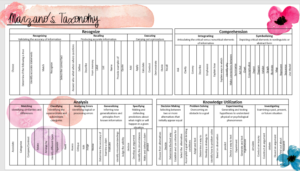
A great tool to use when designing a unit plan or targeted questions is Marzano’s Taxonomy of Educational Objectives. Marzano designed the taxonomy to address standard-based content, provide a wider range of students’ thinking skills, and include research-based thinking to help teachers better prepare for their students. Marzano’s taxonomy is divided into three categories and one knowledge domain. The three categories are the Self-System, the Metacognitive System, and the Cognitive System.
- The Self-System includes beliefs about the importance of knowledge, beliefs about efficacy, and emotions associated with knowledge. Self-system is the highest level of difficulty and includes words such as analyze importance, examine one’s beliefs, and identify an emotional response.
- The Metacognitive System is defined as thinking about one’s thinking. This system addresses specifying learning goals, monitoring the execution of knowledge, and monitoring clarity accuracy. The Metacognitive System is below the self-system and includes language such as examining motivations to learn, self-monitoring goals, determining how well the student knows the knowledge, and determining the accuracy of understanding and defending judgments.
- The Cognitive System encompasses the four levels of Marzano’s Taxonomy. They are knowledge, retrieval comprehension, analysis, and knowledge utilization.

- Knowledge Retrieval- This is the first level and the basic level of recalling information. You may be asked to recall, recognize, or execute a task.
- Comprehension-Comprehension is one step higher than knowledge retrieval. It requires you to recall and identify the correct category of the task. You may be asked to summarize, response, clarify or describe how or why.
- Analysis- The work in analysis becomes more complex. You must categorize, classify, assess, examine a claim, and develop an argument. Analysis has five mental processes: matching, classifying, analyzing errors, generalizing, and specifying. These five mental processes are extensions of knowledge and include the generation of information.
- Knowledge Utilization– This is the final stage of Marzano’s Taxonomy. It includes decision making, problem-solving, and experimental inquiry. The terms that are associated with this stage are based on your observations, testing the idea, debating, and dissecting an argument.

Using Marzano’s Taxonomy can assist teachers in several ways. It can help teachers develop objectives for lessons, generate and understand assessments, redesign standards that are student-friendly, and construct a curriculum of thinking skills. Teaching is constantly evolving and so is teaching research. Marzano’s Taxonomy considers the holistic student and has questions that are research-based and challenging.
A Gift for You
I created a PDF of the four cognitive systems, called Marzano’s Taxonomy of Educational Objectives. It’s easy to use! You can use it while writing your unit or lesson plan, creating targeting questions, or designing a test. This a decorative tool to have on your desk for easy access!

Works Cited
“MarzanoandKendall2007Taxonomy.pdf.” http://earth.callutheran.edu/archived-sites/institutional-research/documents/MarzanoandKendall2007Taxonomy.pdf. Accessed 05 October 2019.
“Marzano’s New Taxonomy.” Intel® Teach Program, 2012. https://www.intel.com/content/dam/www/program/education/us/en/documents/project-design/skills/marzano-taxonomy.pdf. Accessed 05 October 2019.
Millie. “Marzano’s New Taxonomy.” February 11, 2019. https://missmilliemillie.com/2019/02/11/marzanos-new-taxonomy. Accessed 25 September 2019.




Leave a Reply